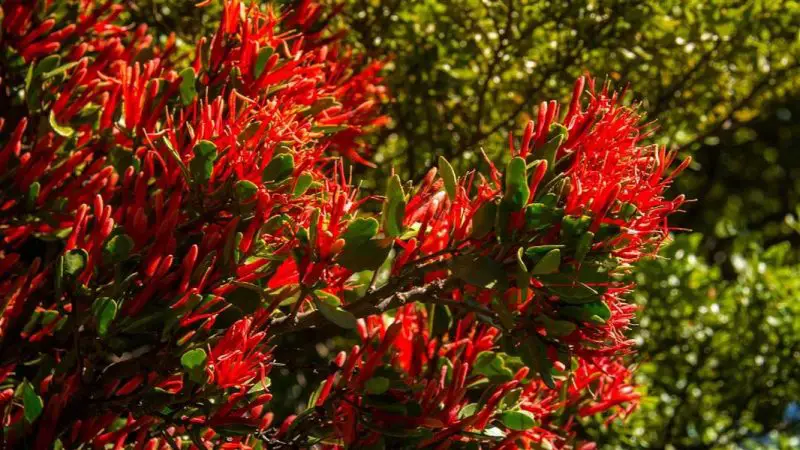Mistletoe is a fascinating plant with a rich cultural history and unique growth habits. Known for its evergreen leaves and seasonal berries, it thrives as a semi-parasitic plant, attaching to host trees to extract water and nutrients. Understanding where mistletoe grows is essential for gardeners, nature enthusiasts, and those curious about its ecological role.
Mistletoe’s natural habitats vary across regions, with different species adapting to specific climates and host trees. This guide explores the ideal conditions for mistletoe growth, including climate, host preferences, and soil types. By learning how and where mistletoe grows, readers can identify potential planting sites, observe natural populations, and ensure healthy, sustainable growth. This comprehensive approach guarantees thriving plants and enhances appreciation for this iconic species.
Types of Mistletoe and Their Natural Habitats

Mistletoe encompasses several species, each adapted to specific climates and host trees. The most common types include European mistletoe (Viscum album), American mistletoe (Phoradendron leucarpum), and dwarf mistletoe (Arceuthobium spp.). European mistletoe thrives in temperate regions, often found on apple, oak, and poplar trees. Its ability to survive mild winters makes it prevalent in parts of Europe and Western Asia. Understanding species differences is crucial for identifying natural habitats and predicting growth patterns.
American mistletoe grows primarily in the southeastern and central United States. It prefers hardwood hosts such as oak, hickory, and elm trees. This semi-parasitic plant attaches to branches and gradually spreads, producing clusters of white berries that provide food for birds. The warmer climates and higher humidity in these regions create ideal conditions for vigorous growth. Gardeners and nature enthusiasts should note that American mistletoe’s survival depends on suitable host trees and proper sunlight exposure.
Dwarf mistletoe is found mainly in western North America, where it parasitizes conifer species like pine, fir, and spruce. Unlike other mistletoe types, it can significantly impact host trees by stunting growth or deforming branches. These species demonstrate mistletoe’s adaptability across environments and highlight the importance of selecting appropriate habitats. Recognizing host preferences and climatic requirements allows gardeners and researchers to observe natural populations, cultivate mistletoe successfully, and manage potential ecological impacts responsibly.
Climate and Soil Conditions Favoring Mistletoe Growth
Mistletoe thrives in regions with temperate to subtropical climates. European mistletoe prefers mild winters and moderate rainfall, while American mistletoe adapts to warmer, humid environments. Adequate sunlight is essential, though partial shade on host trees can also support healthy growth. Temperature and humidity influence seed germination, branch attachment, and berry development, making climate a critical factor for mistletoe survival.
Soil type indirectly affects mistletoe growth through its impact on host tree health. Well-drained soils support strong host trees, which in turn provide stable attachment points and nutrient access for mistletoe. Sandy loam or fertile clay soils are ideal, as they retain moisture without waterlogging roots. Nutrient-rich soil encourages vigorous host tree growth, giving mistletoe the support it needs to flourish. Poor soil conditions or compacted ground can weaken hosts, limiting mistletoe establishment and reducing berry production.
Microclimate considerations further enhance mistletoe success. Areas with consistent rainfall, low wind exposure, and moderate sunlight create favorable conditions for seed dispersal and attachment. Gardeners and ecologists must consider local weather patterns, frost frequency, and seasonal changes when identifying potential growth sites. Understanding these environmental factors ensures that mistletoe plants establish successfully, maintain strong connections to hosts, and produce healthy foliage and berries, contributing to both ecological balance and ornamental appeal.
Common Host Trees for Mistletoe
Oak Trees
Oak trees are among the most frequent hosts for mistletoe, providing sturdy branches and reliable nutrient access. Both American and European mistletoe species attach successfully to oaks, benefiting from their robust canopy and well-developed branches. The rough, textured bark helps seeds adhere more easily, allowing mistletoe to establish itself securely. Healthy oaks offer consistent sap flow, supporting lush foliage and steady berry production throughout the season. Gardeners often notice that mistletoe grows more densely on older, mature oaks because of the stability and longevity these trees provide.
Mistletoe gradually spreads across oak branches, forming clusters that can be visually striking. While the relationship is semi-parasitic, mature oaks typically tolerate moderate mistletoe presence without severe damage. Maintaining oak health through proper watering, mulching, and pest management enhances mistletoe growth and ensures both host and parasite thrive. Understanding oak compatibility helps gardeners predict growth patterns, manage clusters, and balance ornamental appeal with tree vitality. Observing natural oak-mistletoe interactions also supports local biodiversity, attracting birds and insects that rely on berries and foliage.
Maple Trees
Maple trees serve as ideal mistletoe hosts in temperate regions due to their broad branches and dense canopy. These trees provide structural support, stable sunlight exposure, and nutrient access that mistletoe requires. Seeds adhere effectively to the bark, facilitating secure attachment. Once established, mistletoe develops lush green leaves and clusters of white berries, which feed birds and contribute to local ecological networks. Gardeners often favor maples because they tolerate moderate parasitism while maintaining ornamental value.
To ensure both maple and mistletoe thrive, proper tree care is essential. Regular watering, fertilization, and disease monitoring support strong sap flow, benefiting mistletoe attachment and growth. Overgrowth should be controlled through careful pruning to prevent weakened branches or reduced tree vitality. By understanding maple-mistletoe interactions, gardeners can cultivate visually appealing landscapes while sustaining healthy host trees. Maintaining this balance encourages seasonal berry production and preserves natural wildlife habitats.
Apple Trees
Apple trees are popular hosts for European mistletoe, especially in orchards and gardens. Their branching structure offers multiple attachment points, and nutrient-rich sap supports vigorous mistletoe growth. The semi-parasitic plant develops dense foliage and clusters of berries that not only enhance visual appeal but also provide food for birds. Mistletoe growth on apple trees highlights an ecological interaction, where both species can coexist without immediate harm to the host when managed properly.
Effective management ensures apple trees remain productive and healthy. Pruning both the host and mistletoe controls parasitic spread, preventing overgrowth that could impair branch strength or fruit yield. Selecting healthy apple varieties, monitoring soil conditions, and providing adequate water and nutrients enhances tree resilience. With careful care, gardeners can enjoy thriving mistletoe alongside robust apple trees, achieving an attractive, ecologically balanced landscape that supports wildlife while maintaining fruit production.
Seasonal Growth and Blooming of Mistletoe
Early Spring Development
Mistletoe begins its active growth in early spring, taking advantage of the rising temperatures and increased sap flow in host trees. This is the phase when dormant buds from the previous season start to swell and elongate, while new leaves begin photosynthesis to support energy production. Stems thicken and extend, anchoring firmly to host branches, ensuring stable nutrient absorption. Gardeners often notice that mistletoe growth accelerates in well-maintained host trees, as healthy trees provide optimal sap flow, moisture, and nutrient availability. Early spring also marks the initial development of berries, which are crucial for reproduction and future seed dispersal.
Environmental conditions strongly influence early spring development. Consistent rainfall promotes host vitality, which indirectly benefits mistletoe, while adequate sunlight enhances leaf photosynthesis and growth rates. Cold snaps or frost events can damage emerging mistletoe shoots, reducing seasonal growth and berry potential. Mulching around the base of host trees and maintaining soil moisture helps minimize environmental stress. Understanding early spring dynamics allows gardeners to anticipate growth patterns, manage clusters effectively, and ensure mistletoe establishes a strong foundation for the flowering and fruiting stages later in the year.
Summer Maturation
Summer is the maturation phase for mistletoe, when energy is consolidated, leaves fully develop, and berries ripen. During this time, the plant strengthens its stems and enhances nutrient storage, ensuring survival through seasonal fluctuations. The parasitic relationship with host trees is critical; strong sap flow supports sustained leaf health and berry production. Birds play an important ecological role by feeding on ripening berries, which helps disperse seeds to other suitable hosts, continuing the species’ life cycle. Gardeners can observe cluster expansion and berry development, which are indicators of plant health and successful seasonal growth.
Maintaining host tree health during summer is vital for mistletoe vigor. Adequate watering, pest management, and disease monitoring prevent stress that could compromise the parasitic plant’s development. Pruning damaged or weak branches supports both host and mistletoe by optimizing light exposure and nutrient distribution. Environmental factors such as drought, excessive heat, or sudden storms can affect mistletoe maturation, so gardeners should ensure host trees are resilient. By understanding summer maturation patterns, gardeners can time interventions, such as selective pruning or watering adjustments, to maximize leaf vitality, berry production, and overall ornamental appeal.
Autumn Flowering and Berry Production
In autumn, mistletoe reaches peak flowering and berry production, providing essential resources for wildlife. White, red, or translucent berries mature fully, attracting birds that feed on them and disperse seeds to new host trees. Some mistletoe species also display small clusters of flowers, which draw pollinators and promote cross-pollination. This period highlights the ecological importance of mistletoe, as it sustains local birds, insects, and other wildlife during cooler months when alternative food sources are limited. Gardeners often use this time to monitor clusters for health and visual appeal, ensuring both ornamental and ecological benefits.
Environmental cues, including decreasing day length and temperature fluctuations, trigger physiological adjustments in mistletoe. Nutrient uptake from healthy host trees ensures robust berry and leaf development, maintaining plant vigor. Gardeners can enhance autumn growth by providing consistent host care, including adequate watering and protection from pests or disease. Monitoring for overgrowth and selectively thinning clusters can prevent excessive parasitism while preserving aesthetic value. Proper seasonal management during autumn ensures mistletoe remains healthy, visually appealing, and capable of successful reproduction for the upcoming year, supporting both the host ecosystem and ornamental landscapes.
Propagation and Spreading of Mistletoe
Natural Seed Dispersal
Mistletoe primarily spreads through natural seed dispersal facilitated by birds. Birds consume the sticky berries during autumn and winter, digesting the pulp but excreting the seeds onto branches of suitable host trees. This process allows mistletoe to colonize new locations, often high in the canopy where seeds are more likely to thrive. The sticky coating of the seeds ensures they adhere securely to branches, providing a stable environment for germination.
Successful natural dispersal depends on the availability of both wildlife and healthy host trees. Birds prefer certain host species, influencing where mistletoe spreads most effectively. Environmental conditions, including temperature, humidity, and branch accessibility, impact seed attachment and germination. Gardeners observing bird activity can anticipate potential mistletoe growth areas. Ensuring host tree health, monitoring seed spread, and understanding wildlife interactions allow gardeners to manage mistletoe propagation responsibly while maintaining ecological balance in the garden or woodland.
Human-Assisted Propagation
Humans can also propagate mistletoe intentionally for ornamental or ecological purposes. Gardeners often collect ripe berries and manually attach them to suitable host branches using sticky adhesives or by pressing seeds directly onto rough bark. Proper placement in areas with adequate sunlight and healthy sap flow increases the likelihood of successful establishment. Human-assisted propagation enables controlled growth, ensuring mistletoe enhances garden aesthetics without overwhelming host trees.
Timing and care are essential for human-assisted propagation. Seeds should be applied during late winter or early spring when host trees are beginning sap flow, which supports rapid seedling growth. Regular monitoring of attached seeds prevents desiccation and encourages healthy establishment. Gardeners may thin overly dense clusters to maintain host tree vitality. By understanding human-assisted propagation techniques, gardeners can cultivate mistletoe responsibly, achieving visually striking clusters while supporting ecological functions such as wildlife food sources and natural biodiversity.
Environmental Conditions Affecting Mistletoe Growth
Light and Sun Exposure
Mistletoe growth is strongly influenced by light availability. While the plant is parasitic, its leaves still perform photosynthesis and benefit from sufficient sunlight. Host trees growing in open areas or with well-exposed branches provide optimal light conditions, enabling mistletoe to produce robust stems, healthy leaves, and abundant berries. Clusters located in shaded portions of the canopy often exhibit slower growth and fewer berries, as photosynthetic activity is limited.
Sun exposure also affects the timing of flowering and seed maturation. Well-lit clusters can begin flowering earlier in the season, promoting timely berry development and seed dispersal. Conversely, low-light conditions may delay these processes, reducing overall reproductive success. Gardeners monitoring host tree canopy density can manage surrounding vegetation to improve light access for mistletoe clusters. Understanding the relationship between light and growth ensures mistletoe remains healthy, visually appealing, and capable of sustaining local wildlife that relies on its berries during scarce periods. Proper sun management helps gardeners achieve balanced ornamental and ecological benefits.
Temperature and Humidity
Temperature and humidity play a critical role in mistletoe survival and growth. Moderate climates with seasonal variations create ideal conditions for leaf expansion, stem thickening, and berry maturation. Excessive heat can stress the plant and limit growth, while prolonged cold or frost may damage buds, reducing flowering and fruiting. Similarly, humidity levels affect moisture retention in leaves and berries, influencing photosynthesis and overall plant vigor.
Stable environmental conditions allow mistletoe to develop consistent, healthy clusters. Host trees that maintain proper sap flow in moderate temperatures support robust growth, while erratic weather can disrupt nutrient absorption. Gardeners can mitigate extreme conditions by selecting suitable host trees and monitoring microclimates within their property. Understanding temperature and humidity impacts enables more effective management of mistletoe, ensuring it thrives year after year. Careful attention to these environmental factors enhances ornamental appeal, supports wildlife, and maintains the long-term health of both the parasitic plant and its host tree.
Caring for Mistletoe Throughout the Seasons
Winter Care
During winter, mistletoe growth slows significantly, relying almost entirely on the host tree for nutrients. Cold temperatures, frost, and ice can stress both the parasite and the host, potentially causing damage to branches or clusters. Gardeners should inspect the host tree for weakened limbs and remove them to prevent breakage, indirectly protecting the mistletoe. Minimal intervention is recommended directly on the mistletoe during winter, as handling can damage dormant buds.
Winter is also a critical time for observing bird activity around mistletoe berries. Birds consume the fruit and help disperse seeds, naturally promoting the plant’s spread. By monitoring which branches attract the most bird activity, gardeners can anticipate potential future clusters and plan care accordingly. Maintaining host tree health through proper mulching, soil aeration, and insulation helps ensure stable conditions for mistletoe. Attending to winter care sets the foundation for strong spring growth, preserving both ornamental appeal and ecological function.
Spring Maintenance
Spring marks the most active growth phase for mistletoe. During this period, new leaves emerge, stems elongate, and flowers begin to develop, depending on the species. The health of the host tree is critical, as mistletoe relies on its sap and nutrients. Gardeners should ensure consistent watering, especially after dry winters, and apply balanced fertilization to support both the host tree and parasitic clusters. Light pruning of surrounding branches can improve sunlight penetration without harming emerging buds. Proper pruning and branch management also enhance air circulation, reducing fungal risk and supporting vigorous growth.
This season also initiates berry formation, a vital stage for the plant’s reproductive cycle. Maintaining consistent sap flow and adequate moisture is essential for fruit development. Gardeners should monitor for pests like aphids, scale insects, or spider mites, addressing infestations promptly to prevent damage. Observing sunlight levels and trimming overcrowded vegetation ensures clusters receive optimal light for photosynthesis. By combining attentive watering, pest management, and careful pruning, spring care encourages robust flowering, healthy berry production, and strong stem growth, enhancing the ornamental appeal and ecological benefits of mistletoe in the garden.
Summer Care
Summer is a critical period for mistletoe, as leaves fully mature and berries develop toward ripeness. High temperatures and intense sunlight can stress the plant if the host tree is not adequately hydrated or lacks essential nutrients. Gardeners should regularly monitor soil moisture around the host tree and provide supplemental irrigation during dry spells to maintain steady sap flow to mistletoe clusters. Mulching around the host tree’s base helps retain soil moisture, moderates temperature fluctuations, and indirectly supports mistletoe health. Ensuring the host tree remains vigorous also strengthens stems and prevents leaf drop or stunted growth in the parasite.
This season also brings increased bird activity, as many species feed on developing berries, aiding in natural seed dispersal. Observing bird interactions helps gardeners anticipate where future mistletoe clusters may establish. Avoiding unnecessary disturbance to the clusters during this time is important, as handling or pruning can reduce flowering, berry quality, and overall plant vitality. By combining proper irrigation, mulching, pest monitoring, and minimal interference, gardeners can ensure mistletoe thrives through summer, producing healthy leaves, robust berries, and maintaining both visual appeal and ecological benefits throughout the season.
Autumn Preparation
Autumn is a critical season for mistletoe, as it marks peak berry ripening and increased bird activity. Birds feeding on berries play a vital role in natural seed dispersal, helping the plant propagate to new branches and nearby host trees. Gardeners should avoid removing clusters during this time to preserve reproductive success. Observing the density of mistletoe clusters can also help identify areas where thinning might be necessary. Removing excess growth in specific sections prevents overcrowding, which can stress both the mistletoe and the host tree, ensuring clusters remain healthy and sustainable.
Temperature fluctuations in autumn stimulate leaf hardening and full berry maturation, preparing the plant for winter dormancy. Maintaining host tree health is essential through consistent watering and removing damaged or diseased branches. Light mulching around the host’s root zone helps protect against early frost and stabilizes soil moisture levels. By carefully managing the host tree and mistletoe clusters, gardeners ensure the plant survives winter in strong condition, maximizes berry production, and maintains ornamental appeal. Autumn care supports ecological benefits while preserving the visual charm and seasonal decoration potential of mistletoe.
Common Problems and How to Manage Them
Pest Infestations
Mistletoe can attract a variety of pests that negatively impact both the parasite and its host tree. Aphids, scale insects, and spider mites are the most common culprits, feeding on leaves, stems, and berries. Their activity reduces photosynthesis, weakens stems, and can lead to poor berry development. Regular inspection is crucial, particularly during spring and summer when pests are most active. Early detection allows gardeners to take timely action before infestations spread and cause significant damage.
Integrated pest management is the most effective approach for controlling these pests. Encouraging natural predators such as ladybugs and lacewings, along with the use of insecticidal soaps or horticultural oils, helps manage infestations without harming beneficial insects or birds that feed on the berries. Maintaining the host tree’s vigor through proper watering, mulching, and fertilization also reduces susceptibility to pests. Combining careful monitoring with safe treatment practices ensures mistletoe remains healthy, supports vibrant leaf growth, and produces abundant berries, while maintaining the ecological balance and visual appeal of the garden.
Fungal and Disease Issues
Fungal infections like powdery mildew and sooty mold can threaten mistletoe clusters and their host trees. These diseases thrive in humid environments, especially when air circulation is limited, causing leaf discoloration, stem damage, and weakened clusters. Infected leaves may fall prematurely, and berry production can decline, impacting both ornamental value and natural propagation. Gardeners should regularly inspect clusters and promptly remove any affected material to prevent the spread of disease.
Preventive care is essential for fungal management. Improving airflow around the host tree through selective pruning, spacing, and trimming surrounding vegetation helps reduce moisture accumulation, limiting fungal growth. Fungicide applications, used carefully during high-risk periods, can protect healthy mistletoe without harming nearby plants or wildlife. Consistent practices such as proper pruning, controlled watering, and mulching enhance plant resilience, allowing mistletoe to withstand fungal threats. Maintaining healthy clusters preserves both the aesthetic appeal and ecological benefits, ensuring vigorous growth, robust berry development, and long-term vitality.
Environmental Stress and Damage
Mistletoe is sensitive to environmental stress, which can impact growth, berry production, and overall health. Extreme weather events, such as drought, heat waves, or prolonged cold snaps, can weaken both the mistletoe and its host tree. Excessive sun exposure or lack of water may cause leaf wilting, stunted growth, and reduced sap flow, limiting nutrient availability for the parasite. Additionally, strong winds or storms can physically damage branches, break stems, or dislodge clusters, reducing flowering and berry development.
To mitigate environmental damage, gardeners should focus on maintaining host tree vigor through consistent watering, especially during dry periods. Mulching around the root zone stabilizes soil moisture and temperature, while light pruning can improve sunlight exposure and airflow to clusters. Selecting healthy host trees in protected locations reduces vulnerability to harsh conditions. Monitoring local weather patterns and taking preventive measures during extreme conditions helps ensure mistletoe thrives. With careful attention to environmental factors, gardeners can maintain visually appealing, healthy mistletoe clusters that continue to provide ecological benefits and ornamental value throughout the year.
Harvesting and Using Mistletoe
Harvesting mistletoe requires careful timing and handling to preserve both plant health and its decorative value. The ideal period for collection is late autumn to early winter, when berries are fully ripe and leaves remain vibrant. Gardeners should use clean, sharp pruning tools to cut clusters from host branches, taking care not to damage the host tree. Only mature, healthy clusters should be harvested, leaving smaller or weaker clusters intact to ensure continued growth and reproduction. Wearing gloves is recommended, as mistletoe berries and sap can cause skin irritation for some individuals.
Once harvested, mistletoe can be used for a variety of decorative and cultural purposes. Traditional holiday décor, such as hanging clusters in doorways or creating wreaths, benefits from the plant’s bright green leaves and white berries. In addition to decoration, mistletoe holds symbolic significance in many cultures, representing fertility, protection, and good fortune. When using mistletoe indoors, it is important to ensure it is placed out of reach of pets and children, as berries are mildly toxic if ingested.
Proper storage and care after harvesting can extend the life and appearance of mistletoe clusters. Storing in a cool, shaded area prevents leaves from wilting and berries from drying out too quickly. Light misting can help maintain moisture, and clusters can be gently reshaped for aesthetic purposes. By harvesting responsibly and using sustainable practices, gardeners can enjoy beautiful, long-lasting mistletoe displays each holiday season while ensuring the plant continues to thrive on its host trees for years to come.
Overwintering Mistletoe and Seasonal Protection
Winter presents unique challenges for mistletoe, including cold temperatures, frost, and reduced sunlight. Although mistletoe is semi-parasitic and relies on its host for nutrients, extreme winter stress can damage leaves, berries, and stems. Gardeners should focus on maintaining the health of the host tree, as a strong host supports cluster resilience. Applying a layer of mulch around the base of the host tree helps regulate soil temperature, protect roots, and preserve moisture, indirectly benefiting the mistletoe.
Monitoring clusters during winter is essential to detect damage early. Broken stems or frost-damaged leaves should be removed carefully to prevent decay and potential disease. Avoid heavy pruning in winter, as clusters are in a dormant state, and excessive cutting can reduce the plant’s ability to recover in spring. Gardeners can also assess the density of mistletoe clusters to prevent overloading host branches, reducing the risk of breakage under snow or ice.
Winter care also includes protecting mistletoe from wildlife or human disturbance. Birds feed on berries but generally do not harm clusters; however, heavy activity may dislodge clusters if the host is weak. Placing visual barriers or gently redirecting foot traffic can prevent accidental damage. By providing consistent protection, maintaining host tree health, and minimizing disturbance, gardeners ensure that mistletoe survives winter intact, emerges robust in spring, and continues to thrive for both ornamental and ecological purposes.
FAQ About Where Mistletoes Grow
What conditions are best for mistletoe to thrive?
Mistletoe grows best on healthy host trees in areas with partial sunlight and adequate moisture. Avoid planting on stressed or diseased trees. Good air circulation reduces fungal risks, and maintaining host vigor ensures mistletoe receives sufficient nutrients for leaf growth, flowering, and berry production throughout the year.
Can mistletoe harm its host tree?
While mistletoe is semi-parasitic, heavy infestations can weaken host branches and reduce overall tree vigor. Light, controlled clusters generally do not harm healthy trees. Regular monitoring, pruning excess clusters, and maintaining host tree health help balance growth, preventing structural damage and allowing both host and mistletoe to coexist safely.
When is the best time to harvest mistletoe?
Late autumn to early winter is ideal for harvesting mistletoe when berries are ripe and leaves remain vibrant. Use sharp, clean tools and take care not to damage the host tree. Leave smaller clusters untouched to ensure ongoing growth and future propagation, while harvesting mature clusters for decorative or traditional purposes.
How can I protect mistletoe during winter?
Protect mistletoe by maintaining host tree health and applying mulch around the base to regulate soil temperature and moisture. Avoid heavy pruning in winter, and minimize disturbance from wildlife or foot traffic. Careful monitoring of clusters and host branches ensures the plant survives frost and emerges robust in spring.
Are mistletoe berries safe for humans and pets?
Mistletoe berries are mildly toxic if ingested. Humans and pets should avoid consuming berries, as they can cause nausea, vomiting, or digestive upset. When using mistletoe for decoration, place it out of reach of children and animals, and always handle clusters with gloves to prevent skin irritation from sap or leaves.
Conclusion
Mistletoe is a unique and visually striking plant that thrives when paired with healthy host trees and proper care. By understanding its growth requirements, seasonal needs, and potential environmental stresses, gardeners can encourage vibrant leaves, abundant berries, and sustainable clusters year after year. Responsible harvesting, winter protection, and attentive seasonal maintenance enhance both ornamental and ecological value. Whether used for decoration or wildlife support, well-cared-for mistletoe provides lasting beauty and cultural significance. With consistent care and mindful management, gardeners can enjoy healthy, thriving mistletoe displays that flourish across seasons, enriching any landscape.






